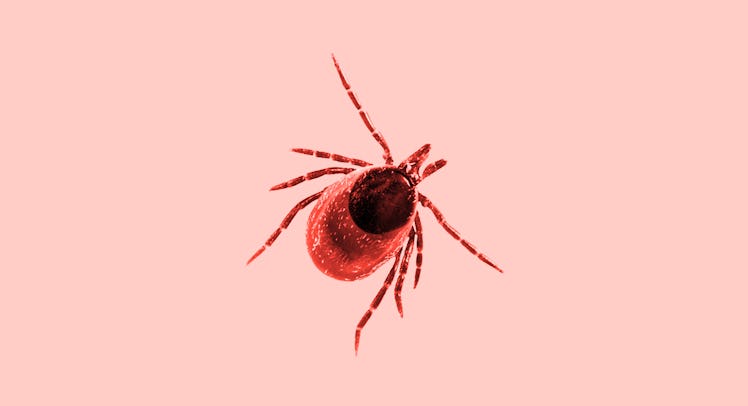5 Truly Tragic Ways Ticks Can Kill Your Dog
This is your dog. This is your dog on ticks.

What does a tick bite look like on a dog? Are you worried about your uniquely named pet? Did you find a tick bite on your dog? Does your dog have symptoms of dog tick diseases? what even are symptoms of tick-borne diseases in dogs?
Reader, fear not: you’ve come to the right place. Dog tick diseases can be awful, but they can also be nothing at all. Ticks on dogs can be a sign of something bad — like anaplasmosis in dogs or infection — but knowing the tick bite symptoms in dogs can help you be aware of what may just be a normal bug extraction or what could be a sign of something worse, like dog tick diseases.
After finding tick bites on dogs, or even an infected tick bite on dogs, you might be scared of what’s next. First, it’s important to act preventatively. Applying tick prevention medications and regularly checking for infected tick bites on dogs can help. Still, even knowing the dog tick diseases and acting quickly can sometimes not be enough to stem the danger of dog tick diseases.
Knowing what symptoms to look for after seeing a tick bite on your dog, and types of tick diseases in dogs to be aware of, and when to go to the veterinarian could ultimately make the difference between a dog’s life and death. From anaplasmosis in dogs to Rocky Mountain spotted fever, these are the tick bite symptoms in dogs pet owners need to look out for.
Canine Anaplasmosis
Typically transmitted by deer and brown dog ticks, canine anaplasmosis in dogs is a bacterial infection that causes joint pain, fever, lethargy, and loss of appetite about one week after Fido is bitten. Veterinarians can identify it with a battery of tests, and the prognosis is pretty good if you catch the disease early and begin treating your dog with the antibiotic doxycycline. In rare instances it can cause seizures and kidney disease, both of which can be fatal.
Canine Babesiosis
Sadly, this does not mean your dog is such a babe that it’s diagnosable. Unlike other tick-borne diseases, canine babesiosis is caused by not a bacteria but a malaria-like parasite transferred by deer ticks that destroys red blood cells. This type of tick bite symptoms in dogs include fever, lack of energy and appetite, pale gums, dark urine, discolored stools, weight loss, and an enlarged abdomen occur within two weeks of a bite. Babesiosis is difficult to diagnose and challenging to treat, because even though drug therapy and blood transfusions can help, dogs can die from low blood pressure and shock.
Rocky Mountain Spotted Fever
Transmitted by lone-star, wood, and American dog ticks, Rocky Mountain spotted fever is something of a triple threat for pups (and humans!). Rickettsia rickettsii, the bacterium behind the disease, acts very similarly to Ehrlichia and infects dogs in acute and subclinical phases. But with RMSF, the acute stage is the most serious. Within two weeks a tick bite on a dog, dogs may experience loss of appetite, cough, pinkeye, swelling of the legs and joints, seizures, skin lesions, and renal failure. The good news is that it can be treated with antibiotics. The bad news is that, untreated, it can be fatal.
Canine Ehrlichiosis
Canine ehrlichiosis, otherwise known as “canine hemorrhagic fever” and “canine typhus,” affected many military dogs in the Vietnam War. Transmitted by the lone-star tick, Canine ehrlichiosis rears its head in three separate waves of tick bite symptoms in dogs. During the acute phase (one to three weeks after a tick bite on dog) Ehrlichia bacteria infect the dog’s white blood cells and reproduces inside of them. This causes fever, depression, lethargy, loss of appetite, shortness of breath, joint pain and stiffness, and bruises.
Most dogs recover from the acute phase but, if they don’t, they enter the subclinical phase, which can last for months or years as the bacteria remain latent. Until the chronic phase, which can result in weight loss, anemia, behavioral problems, bleeding, eye inflammation, fluid accumulation in the hind legs. A dog’s long-term health depends on detecting the Ehrlichia bacteria in the acute phase, when it is still treatable with antibiotics.
Otherwise, dogs may need intravenous fluids or blood transfusions to survive.
Lyme Disease
Although it’s the most well-known tick disease in humans, Lyme disease is less of a concern for dogs. Deer ticks have to attach to land a tick bite on dog for 48 hours in order to pass on the Borrelia bacteria that cause the disease, and only about 10 percent of dogs exposed will actually contract Lyme. With the help of antibiotic treatment, it’s seldom fatal.
Hopefully, this information will ensure that fewer “good boys” and “good girls” become statistics.